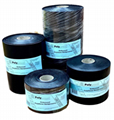| Model: | - |
|---|---|
| Brand: | customize |
| Origin: | Made In China |
| Category: | Construction & Decoration / Waterproof Materials |
| Label: | Malthoid dampcourse , bitumen dampcourse , Malthoid |
| Min. Order: | 1000 pc |
| Last Online:14 Oct, 2025 |
Malthoid/ Bitumen Damp Proof Course
Description
Malthoid is a type of bituminous Damp Proof Course (DPC) used in building construction to prevent moisture from rising up from the ground into walls. It's a flexible, two-ply felt material saturated with bitumen and coated with fine sand to prevent sticking during installation. Malthoid DPC is inert to lime in mortar mixes, making it suitable for use in various building applications.
Key features and benefits of Malthoid DPC:
· Waterproof Barrier: It acts as a moisture-resistant barrier, preventing the upward movement of water and moisture.
· Flexible and Easy to Install: Its flexibility allows for quick and easy installation in various applications.
· Sand Coating: The fine sand coating prevents sticking and simplifies handling.
· Suitable for Various Applications: It's used as a moisture barrier under bottom plates, between timber jack studs and piles, and as a flashing under timber.
· Durable and Long-lasting: Malthoid DPC meets durability requirements for damp proof courses.
· Inert to Lime: It's resistant to the alkaline nature of lime in mortar, preventing degradation.
Applications of Malthoid DPC:
· Damp Proof Course in Brickwork: Used as a horizontal barrier to prevent moisture from rising in brick or block walls.
· Waterproofing: Can be used to waterproof flat roofs and other surfaces.
· Moisture Barrier: Used as a barrier between different materials, such as timber and concrete.
· Under Corrugated Iron Water Tanks: Prevents condensation and corrosion.
Package:
50mm x20m roll
75mm x20m roll
90mm x20m roll
110mm x 20m roll
150mm x 20m roll
230mm x 20m roll
300mm x 20m roll
350mm x 20m roll
1m x 20m roll
1m x 10m roll
special sizes made to order
Application:
Damp proof course on brick and block walls.
Damp proof course between concrete and timber.
To prevent condensation and corrosion under water tanks, cylinders and all metal structures.











